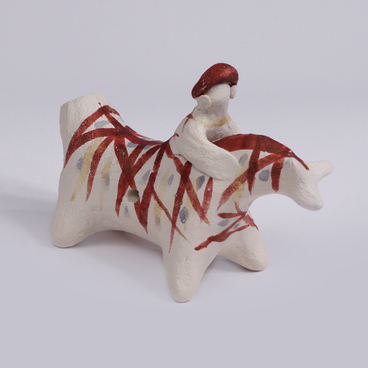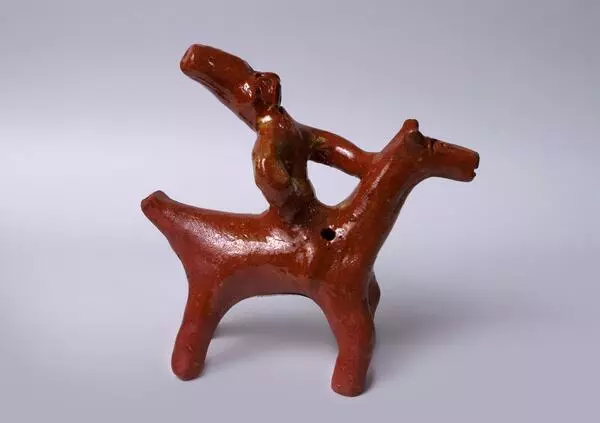The red clay whistle ‘Rooster’ was made in the 20th century in the traditional Sudzha style. It was made by Yury Spesivtsev — a hereditary potter from Kursk. He said that the origins of his favorite craft date back to the era of the archeological Chernyakhov culture that flourished between the 2nd and 5th centuries.
There is a village of Goncharovka not far from the town of Sudzha. It has preserved an old legend saying that once people of God, marching from Jerusalem to the north of Russia, stopped at the Goncharnaya mountain. They predicted that there would be a large pottery trading place in these lands. Interestingly enough, even the first description of the city, made in 1664, mentioned not only the Church of the Ascension and the hostelry but also the Goncharnaya village with 100 households engaged in pottery. This is surprising because in those days even large cities did not have so many potters. It is known that these craftsmen even established their own craft guild. Therefore, in the old days, the Sudzha clay toys were already widely known. They could be found in different cities of Russia, as well as beyond its boundaries — even in Syria or Afghanistan.
As a rule, the clay toys were made for special occasions. The most important holiday of Kursk potters was St. George’s Day (or Yury’s Day). According to the old-style calendar, it was celebrated on April 23. It was a joyful and merry feast: citizens organized big loud fairs, where they sold dishes and vibrant whistles. On the same day, craftsmen and resellers began to deliver their goods to bazaars. They also traveled to other villages and exchanged earthenware for grain, vegetables, and other products.
The holidays of the Nativity of Jesus Christ, the Nativity of the Mother of God, the Ascension Day, the Assumption Day, the Trinity Day, and the Beheading of John the Baptist were also important among the craftsmen. They enthusiastically celebrated Easter and the whole Easter week, as well as the week from Christmas to Epiphany. For the Holiday of the Forty Martyrs of Sebaste on 9 March (according to the old calendar), people made clay magpies, doves, and birds. They were sold near the cathedral along with pies, polyanitsa (a round flatbread), gingerbread, and kalach (a kind of fancy loaf), as well as products made of dough in the form of magpies.
There is a village of Goncharovka not far from the town of Sudzha. It has preserved an old legend saying that once people of God, marching from Jerusalem to the north of Russia, stopped at the Goncharnaya mountain. They predicted that there would be a large pottery trading place in these lands. Interestingly enough, even the first description of the city, made in 1664, mentioned not only the Church of the Ascension and the hostelry but also the Goncharnaya village with 100 households engaged in pottery. This is surprising because in those days even large cities did not have so many potters. It is known that these craftsmen even established their own craft guild. Therefore, in the old days, the Sudzha clay toys were already widely known. They could be found in different cities of Russia, as well as beyond its boundaries — even in Syria or Afghanistan.
As a rule, the clay toys were made for special occasions. The most important holiday of Kursk potters was St. George’s Day (or Yury’s Day). According to the old-style calendar, it was celebrated on April 23. It was a joyful and merry feast: citizens organized big loud fairs, where they sold dishes and vibrant whistles. On the same day, craftsmen and resellers began to deliver their goods to bazaars. They also traveled to other villages and exchanged earthenware for grain, vegetables, and other products.
The holidays of the Nativity of Jesus Christ, the Nativity of the Mother of God, the Ascension Day, the Assumption Day, the Trinity Day, and the Beheading of John the Baptist were also important among the craftsmen. They enthusiastically celebrated Easter and the whole Easter week, as well as the week from Christmas to Epiphany. For the Holiday of the Forty Martyrs of Sebaste on 9 March (according to the old calendar), people made clay magpies, doves, and birds. They were sold near the cathedral along with pies, polyanitsa (a round flatbread), gingerbread, and kalach (a kind of fancy loaf), as well as products made of dough in the form of magpies.



